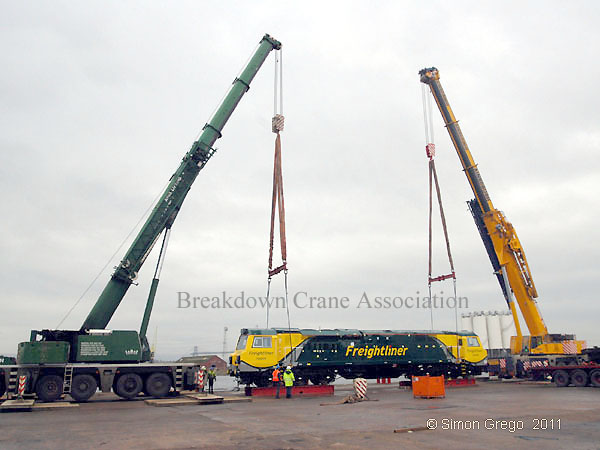
Historical Background
The Demise of the Railway Breakdown Crane
It is tempting to criticise the UK's mainline railways for having disposed of all but seven breakdown cranes as we entered the 21st century, and further reducing the number to just four within a further decade, but the reasons behind the reduction were indisputably sound...
During the zenith of the steam crane era on the railways of Britain, there were as many as 125 steam breakdown cranes in service simultaneously, this figure reached during the latter part of the war years. By 2008, there were only three remaining in service of which one was awaiting repair after an altercation with a high-tension electric line. A fourth which had been damaged in a bridge strike several years earlier, and thought by some unlikely to re-enter service, was repaired and returned to service at the end of 2009. All four are from the 1977 batch of 75-tonne telescopic jib cranes.
The huge reduction in numbers of breakdown cranes is often attributed to the accountants and “bean counters” but the real reasons are not that simple.
The demise of the unfitted goods train, and indeed the fact that the majority of all freight trains now are either block trains of semi-permanently coupled wagons or else consist of vehicles with buckeye couplers, and the wagons themselves have modern suspension systems and are usually bogie vehicles, has greatly reduced the incidence of derailments.
There were 415832 freight vehicles on Britain’s railway system in 1970, and 10182 derailments in that year. In 1987, the number of freight vehicles had reduced to 74247 (of which 25809 were service vehicles, not revenue earning) and the number of derailments to 3171. More than 80% of those derailments occurred in yards and sidings and they were often of a very minor nature. The number of recorded derailments continued to drop from thereon, to about 230 in 1992 and as few as 125 in 2001.
The general rundown of infrastructure (itself largely the result of the demise of wagonload goods traffic), has resulted in the removal of most goods lines and passing loops, and the conversion to bi-directional single lines of many former double track routes. This means that it is now virtually impossible to get a rail-mounted breakdown crane to a derailment or accident site within a reasonable time.
Modern rail-mounted cranes are extremely expensive capital items which not only may cost well into seven figures to buy but also then cost a great deal to keep in working order. In order to be cost effective, modern cranes need to be in more-or-less constant use. The requirements and design of a modern infrastructure crane and a rail-mounted breakdown crane are different to the extent that they are not readily interchangeable. Therefore although it is possible to employ an infrastructure crane cost-effectively it is very difficult to do the same for a breakdown crane.
VolkerRail's Kirow KRC1200UK 125-tonne infrastructure crane stands alongside the NYMR's 1926 Cowans Sheldon 45-ton breakdown crane in Grosmont yard
The Kirow, with both jib and counterweight extended, travels with a heavy section during the restructuring of the NYMR's Bridge 30
Given that the majority of derailments are relatively minor (and also rare), it is much more cost effective and somewhat quicker to maintain and deploy a road-rail type truck equipped with MFD (portable, hydraulically operated, jacking gear) or similar re-railing equipment. This can deal with probably 90% of derailments and can get to site very quickly by road and rail, and the capital tied up in it is perhaps a mere fraction of that in a crane. The equipment is easier to deploy, cheaper to maintain and repair, and requires less training to operate.
For the very rare occasions when a major incident occurs and a crane is required, it makes both economic and operational sense to hire a road-mobile crane. The major hire firms can ensure not only that the crane is utilised effectively (i.e. frequently enough to make a sensible return on the capital investment) but also often enough to make the training and retention of suitably qualified personnel cost effective, something which is now difficult for a rail-mounted crane.
The design of modern rolling stock and locomotives is also a factor. In the days of steam, most locos and stock were strong enough to be lifted or dragged easily by virtually any attachment; nowadays most stock is phenomenally strong in some directions but has to be lifted by specific attachment points only, which usually precludes dragging the object within reach of a rail-mounted crane. This in turn entails lifting at a much greater radius than ever used to be the case, usually resulting in a load-moment which is completely unattainable with a crane that conforms to the railway's loading gauge and axle-load restrictions (this is the reason why it is now routine to use cranes of 1000 or 1200 tonnes capacity at accidents - it isn't the weight to be lifted per se that requires this, rather the radius at which the load has to be lifted together with the fact that the lift usually has to be undertaken by a single crane).

Two road-mobile cranes, of 250 tonne and 350 tonne capacity, working in tandem
to raise a Class 70 loco for bogie removal
